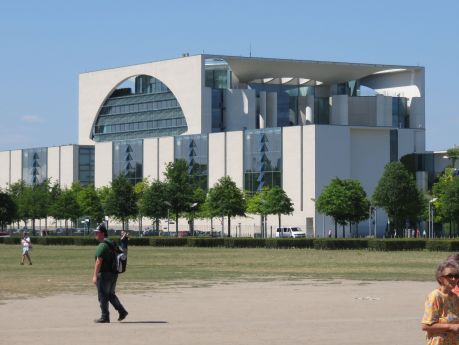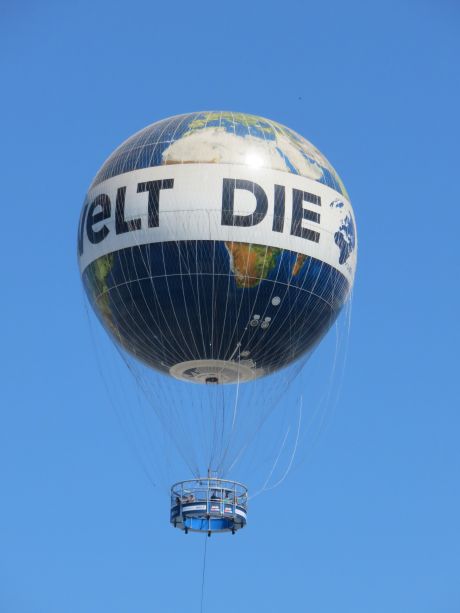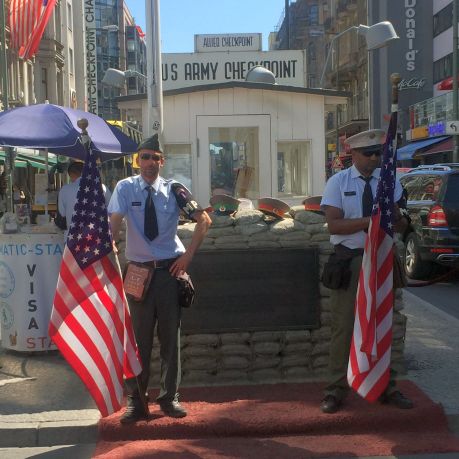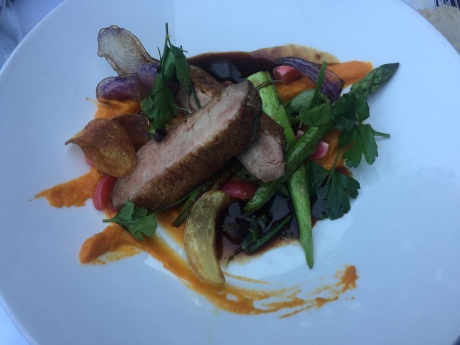Part 7-EASTERN EUROPE: STRUDEL, SCHNITZEL AND STRAUSS, A FEW OF OUR FAVORITE THINGS
Part 6 was Tourists Invade Prague, The City of Concerts, Castles and Korunas
GERMANY
BERLIN REFLECTS THE PAST AS IT MARCHES FORWARD
While our two-week Odysseys Unlimited Discovering Eastern Europe tour focused on cities from which my ancestors had originated, our tour company’s arranged non-guided extension trip to Berlin, Germany at least landed us in the same country from which many of Russ’ family had dwelled. Seven of our tour group faced one another on a four-hour train ride from Prague, Czech Republic, to Berlin. Each country had a conductor who came by to credential our tickets.
On past Odysseys extensions, we’ve always been professionally escorted to our arranged upscale hotel and given a brief intro to the area along the way. How delightedly shocked we were when our German guide, Gisela Ruppel, took us on a several-hour informative and entertaining orientation tour before depositing us at Hotel am Steinplatz. That tour was so encompassing of tourist attractions, how to get around the city, and recommendations for restaurants, museums and shopping, that we were able to spend our precious free time for other activities.
For instance, during our bus tour, with many opportunities to walk, we saw the Brandenburg Gate, the Reichstag, Checkpoint Charlie, remnants of the Berlin Wall, and the Jewish Holocaust Memorial. More about all of these in my What we saw: section.
Where we stayed:
After a long day of train travel followed by our extensive orientation tour, we were all grateful for the warm welcome and cold glasses of fresh juices awaiting us at Hotel am Steinplatz, a stately hotel first opened in 1913, later converted to an assisted living home, and then redesigned and reopened in 2013 as an 84-room boutique hotel paying homage to the 1920s and 1930s styles and décor. The exterior’s Art Nouveau façade merely hints at the retro era fondly embraced on the interior. Black, white and silver flooring, hanging fixtures, and crystal chandeliers adorn a small library, hallways, dining room and jazzy lounge. Large framed photos of bathing beauties, glamorous costumed cabaret performers, and a few celebrities from the era are displayed prominently. A particularly intriguing novelty was outside our room. A video montage of vintage news reels played on a continuous loop. I found it difficult to walk in or out of our room without stopping to watch actual footage of people, events and places of that time.
There was much about this hotel that earmarks it as first class. The air conditioning (AC) worked better than any other European hotel in which we’ve stayed. As the temperatures were in the high 80s and muggy and so few restaurants or museums have AC, we were appreciative to return exhausted and hot to a cooled off room. Another plus is that you plug your phone cord directly into an outlet. No adapter necessary, which has not happened anywhere else in our international travels. The WIFI worked well and for the first time, we didn’t have to re-log in each time we returned to the hotel. Motion sensors lit dimmed lights as you moved through the halls, an effect I found both energy efficient and safety comforting.
The breakfast buffet was outstanding. Our seating options included the restaurant, an outside courtyard, or our choice, inside a long air conditioned corridor situated between the two. Soft music played in the background. This was the first time we saw fat bratwursts boiling in water on the buffet table. Water bottles were filled with parsley leaves to perk up the flavor. Many more varieties of breads, pastries, potatoes, yogurts and granolas from what we’ve seen elsewhere. It was the first time on our trip, even though the option was always available, to have an omelet prepared. It was so perfectly prepared, I switched up my requested ingredients and had one the next morning as well. I would compare the hotel staff’s excellence to the Ritz-Carlton gold standard. They were polite, friendly and went out of their way to help. Our breakfast server must have looked up our names when we checked into the dining room because he addressed us by our last names and politely asked for permission to pour our coffee. I asked for a shot of espresso and that was the only time I had to ask. It was automatically brought after that.
What we learned:
Passes for the vast network of public transportation can be bought from bus drivers, at vending machines in subway stations, or at special marked ticket stations. Be sure to validate the ticket before the first use. If caught without a validated ticket, you can be heavily fined. We rode the bus several times. I marveled that the bus descends on the door-side at each stop and slants to meet the curb for easy boarding. When the bus begins, the side gently rises to an even level.
What we saw:
During the walking portion of our orientation tour, Gisela brought us to Brandenburg Gate, built in 1791 by King Friedrich Wilhelm II as a symbol of peace. The Brandenburg Gate is where President Ronald Reagan famously insisted on June 12, 1987, “Mr. Gorbachev, tear down this wall.” On December 7, 1989, the Berlin Wall was torn down, reuniting the East and West sides of Germany. The Brandenburg Gate is the entrance to an area where many of the historically significant buildings are located.
We crossed the street where the Berlin Wall stood. Now there are permanent brick markers showing where the wall once stood. We moved to a small, caged in area protecting the last vestiges of the Berlin Wall and looked up to see a hovering hot air balloon that said in large bold letters, DIE. Because of where we were standing and because Germany has been the target of multiple terror attacks, it was momentarily disconcerting, until Gisela explained that Die is a local newspaper and the word means “world”. The hot air balloon was simply an advertisement vehicle.
On the western end of the Bundesband (the strip of federal buildings that stretches across the bend in the River Spree to form a symbolic link between East and West) sits The Federal Chancellery. Roughly comparable in function to the American White House, the Reichstag is the only building that can eclipse its symbolic significance. The Chancellery is where Hitler committed suicide in his bunker. Due to its unusual design, locals refer to it as the “Washing Machine.”
Built in 1894, the Reichstag was built for the Diet of the German Empire, which was then succeeded by the Reichstag of the Weimar Republic, which evolved to become the Reichstag of Nazi Germany. Today, the term Reichstag mainly refers to the building, while Bundestag (Federal Diet) refers to the institution.
A 20-minute walk behind the Brandenburg Gate is Museum Island, called Unter den linden in German, meaning “under the linden trees.” The wide boulevard runs from the City Palace to Brandenburg Gate.
In front of the Chancellery are the 2,711 concrete slabs arranged in grid patterns on an uneven terrain that comprise The Jewish Holocaust Memorial, dedicated in 2005 to the Europe’s murdered Jews. As I wove between rows of the multi-sized rectangular blocks, the sun cast shadows that alternated between light and dark. The stark, simple design by architect Peter Eisenman and engineer Buro Happold evoked in me a calm-within-a-storm feeling. At night, the Memorial is lit up. Maybe to bring light where dark evil once stood?
Of course, I knew about the genocide of Jews and I knew gypsies had also been sent to concentration camps. I did not know that nearly 200,000 gypsies perished in the camps or that instead of being forced to bear a gold star on their clothes, they wore triangles.
We briefly stopped at Checkpoint Charlie, one of three checkpoints used by Western Allies during the Cold War to mark the best-known Berlin Wall crossing point between the East and West sides. In military jargon, the points were Alpha, Bravo and Charlie. As a person raised in a military family, I found it off-putting that a symbolically significant place is now a tourist-joke. Two military dressed men stood waving American flags stand in front of the guardhouse in the middle of the street, but the sloppiness of their “uniforms” and their acceptance of money for mugging for photos with tourists made me uncomfortable.
The Bebelplatz is a public square that was the site of a 1933 Nazi book burning hosted by the nationalist German Student Association. On that date, they turned 20,000 books to ashes. There is now a memorial by Micha Ullamn set into the plaza’s cobblestones. A glass plate offers a view of empty bookcases, large enough to hold 20,000 books. Etched into the glass is a line from Heinrich Heine’s play, “Almansor”: “Das war ein Vorspiel nur, dort wo man Bücher verbrennt, verbrennt man am Ende auch Menschen.” (“That was only a prelude; where they burn books, they will in the end also burn people.”). Humboldt University students hold a book sale in the square every year to mark the anniversary.
Russ and I visited two museums. The more interesting of the two was the Nefertiti Exhibition at the Neues Museum. Opened in 1855, the large neoclassical designed building was partially destroyed by WWII bombing, but the beauty of the museum’s original or renovated architectural styling is not to be missed. We had heard the Nefertiti Exhibit was amazing, and it is. The amount of Egyptian pottery, statues, jewelry, sarcophagi seemed to be a limitless history depicted in found objects d’art. The colored bust of a very regal Nefertiti was the highlight, but no photos were allowed.
What we ate. What we drank:
The highly recommended pub a short walk from our hotel had such great food at reasonable prices that we returned the next day as well. Dicke Wirtin Pub (Fat Landlady) has been serving traditional fare since the 1960s. There are many small restaurants around it on the same block but this was the only one crowded with people waiting to be seated. Both nights, Russ ate Riesenbratwurst mit Bayrischkraut und Petersilienkartoffeln (Giant Bratwurst with Bavarian herb and parsley potatoes) and drank Kongi Pilsner. His brats were so long they curved around the dinner plate. Sauteed cabbage and onion, and roasted potatoes accompanied his brats. I ate Schweinebraten mit Rotkohl und Klößen (Roast pork with red cabbage & dumplings) the first night and drank Grüner Veltliner (Green Veltliner, a variety of a white wine grape grown primarily in Austria, Slovakia, and the Czech Republic. The cabbage was a bit sweeter than I am used to. The dumplings were two large doughy balls that were great for wiping up every last trace of the red wine gravy covering the pork. The second night I ate Paniertes Geflügelschnitzel, warmer Kartoffelsalat, Gurkensalat (Breaded poultry cutlet, warm potato salad, cucumber salad). The schnitzel covered the plate. The cucumber salad was a fresh counterpoint to the rich potato salad.
Russ and I don’t travel to foreign lands to expressly go shopping. Not that we don’t shop for souvenirs when the opportunity arises, but we made it a point to visit KaDeWe (Kaufhaus des Westens), allegedly the largest enclosed shopping center in Europe with 640,000 square feet of selling space. What drew us was the hype about their famous 6th floor of international foods and boutique restaurants. We chose to wander each floor and work our way up, enjoying the air conditioning. Each floor flows from one vendor to another, without walls. Hungry, just wanting a light lunch, and unable to make a decision about which of the pricey places to sit (and not wanting to perch on stools instead of chairs), we ended up at a baked potato place, where you choose the topping. The baked potatoes are large. I chose a tasty chicken ragout, which was served in a side bowl. Russ had sour cream and herbs on his. There is also a 7th floor, set up like a cruise ship cafeteria, with bowl after bowl of international offerings sitting under heat lamps or on ice. The food didn’t appear that appetizing and the room was uncomfortably warm due to the sun beating down on the glass ceiling.
One last meal in Berlin and our final meal on this vacation. We wanted it to be something special. Reinhard’s am Kurfurstendamm was a great choice. The first two street-side cocktail tables are for people only drinking. We sat one row up, designated for diners. White linen tablecloths and napkins set the tone for this well-known restaurant that is a local favorite We drank Markus Schneider’s Black Print from Pfalz, Germany, a cuvee from cabernet sauvignon, syrah, and merlot. Tasted of blackberry and smoke, and paired well with our meals. I had two thick slices of roasted duck, and asparagus on a bed of pureed sweet potatoes. Russ ate steak frites, a wonderful piece of meat cooked exactly as requested. Came with a tasty Béarnaise sauce and a side salad.
Our journey of countries in Eastern Europe was finished. The memories will last forever, enriched by what we saw, ate, learned, or who we met. As personally special as this particular trip was for me, I know our next adventure will be coming again soon.
www.hotelsteinplatz.com/
www.visitberlin.de
www.kadewe.de/
www.smb.museum/en/museums-institutions/neues-museum/home.html
www.dicke-wirtin.de
www.restaurant-reinhards.de
Karen Kuzsel is a writer-editor based in the Orlando area who specializes in the hospitality, entertainment, meetings & events industries. She is an active member of ILEA and MPI and is now serving on the 2017 – 2018 MPI Global Advisory Board for The Meeting Professional Magazine for the third consecutive year. She is a member of the Society of Professional Journalists. Karen writes about food & wine, spas, destinations, venues, meetings & events. A career journalist, she has owned magazines, written for newspapers, trade publications, radio and TV. As her alter-ego, Natasha, The Psychic Lady, she is a featured entertainer for corporate and social events. karenkuzsel@earthlink.net; www.ThePsychicLady.com; @karenkuzsel; @thepsychiclady. Food photos for this series by Karen Kuzsel.
All other Photos by Russ Wagner, a retired government planner/builder who has a passion for trains, travel and taking photographs.




















Thank you so much for helping me relive our Odysseys adventure therr in May. It truly was a great trip. Odysseys Unlimited is a wonderful tpuring compamy. This was our 4th trip with them.
Which other trips have you done? A favorite? Thank you for reading my blog story. I’ve written about all of our Odysseys journeys.
Peace,
Karen